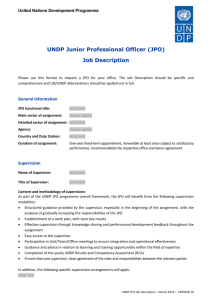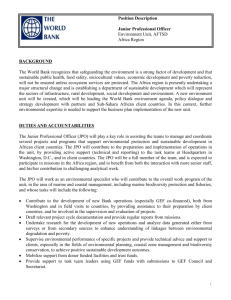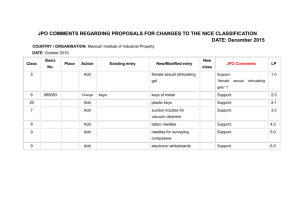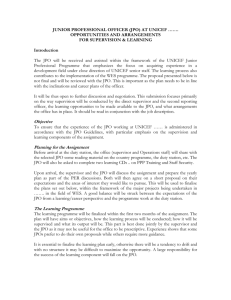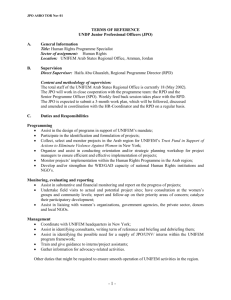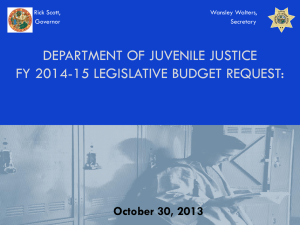JPO Phase I Study Guide Juvenile Probation Officer (JPO) Phase I
advertisement
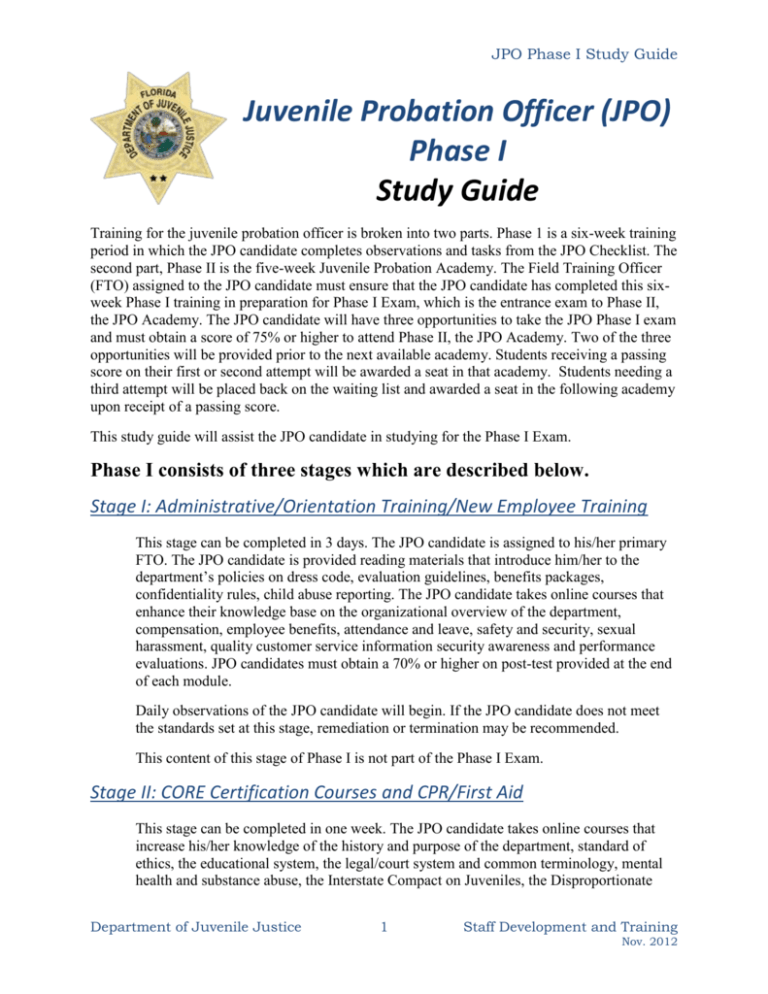
JPO Phase I Study Guide Juvenile Probation Officer (JPO) Phase I Study Guide Training for the juvenile probation officer is broken into two parts. Phase 1 is a six-week training period in which the JPO candidate completes observations and tasks from the JPO Checklist. The second part, Phase II is the five-week Juvenile Probation Academy. The Field Training Officer (FTO) assigned to the JPO candidate must ensure that the JPO candidate has completed this sixweek Phase I training in preparation for Phase I Exam, which is the entrance exam to Phase II, the JPO Academy. The JPO candidate will have three opportunities to take the JPO Phase I exam and must obtain a score of 75% or higher to attend Phase II, the JPO Academy. Two of the three opportunities will be provided prior to the next available academy. Students receiving a passing score on their first or second attempt will be awarded a seat in that academy. Students needing a third attempt will be placed back on the waiting list and awarded a seat in the following academy upon receipt of a passing score. This study guide will assist the JPO candidate in studying for the Phase I Exam. Phase I consists of three stages which are described below. Stage I: Administrative/Orientation Training/New Employee Training This stage can be completed in 3 days. The JPO candidate is assigned to his/her primary FTO. The JPO candidate is provided reading materials that introduce him/her to the department’s policies on dress code, evaluation guidelines, benefits packages, confidentiality rules, child abuse reporting. The JPO candidate takes online courses that enhance their knowledge base on the organizational overview of the department, compensation, employee benefits, attendance and leave, safety and security, sexual harassment, quality customer service information security awareness and performance evaluations. JPO candidates must obtain a 70% or higher on post-test provided at the end of each module. Daily observations of the JPO candidate will begin. If the JPO candidate does not meet the standards set at this stage, remediation or termination may be recommended. This content of this stage of Phase I is not part of the Phase I Exam. Stage II: CORE Certification Courses and CPR/First Aid This stage can be completed in one week. The JPO candidate takes online courses that increase his/her knowledge of the history and purpose of the department, standard of ethics, the educational system, the legal/court system and common terminology, mental health and substance abuse, the Interstate Compact on Juveniles, the Disproportionate Department of Juvenile Justice 1 Staff Development and Training Nov. 2012 JPO Phase I Study Guide Minority Contact, and juvenile sexual offenders. JPO candidates must obtain a 70% or higher on post-test provided at the end of each module. Ideally, JPO candidates will also become certified in CPR/First Aid during this stage of the Phase I. Although the completion of Phase I is not final until this certification has been obtained, attendance in this training is based on the availability of the course. Daily observations of the JPO candidate will continue. If the JPO candidate does not meet the standards set at this stage, remediation or termination may be recommended. Course content related to CPR and First Aid is not part of the Phase I Exam. Stage III: Job Observations and Activities This stage can be completed in four and a half weeks. During this stage, the JPO candidate gains understanding of job expectations, youth behaviors, and appropriate interactions with youth, public, and other staff. JPO candidates will participate in instructor-led training to enhance their understanding and skills in the use of the department’s operating system, the Juvenile Justice Information System (JJIS). An evaluation of the employee’s basic computer skills is conducted. The JJIS training is subject to class availability, and students may have to take this course in Stage I or II if necessary. JPO candidates will participate in a list of observations and activities that are design to provide an understanding of their local resources, detention screening process, the intake process, detention facilities, courtroom procedures, supervision, staffings, commitment, and specialized cases. An evaluation of the JPO candidate’s writing skills will be conducted during this stage. The JPO candidate must be accompanied by a certified juvenile probation officer or a staff member that is certified in Protective Action Response (PAR) during the completion of all observations and activities. The FTO will meet with the JPO candidate after the completion of each set of observations and activities to answer any questions the JPO candidate may have about the process. Daily observations of the JPO candidate will continue. If the JPO candidate does not meet the standards set at this stage, remediation or termination may be recommended. Prior to attending the JPO academy each JPO candidate must pass the pre JPO academy examination with a score of 75% or better. Items for the pre JPO academy exams are developed from the objectives found in the JPO Checklist and the objectives for each of the pre academy courses taken on the learning management system. Upon the successful completion of Phase I, the JPO candidate will attend the Juvenile Probation Officer Academy. The academy is a five week certification course. Successful completion of the academy and the certification exam will result in the JPO candidate becoming a certified Juvenile Probation Officer. Department of Juvenile Justice 2 Staff Development and Training Nov. 2012 JPO Phase I Study Guide JPO Pre Academy Checklist Examination Objectives Local Resource Orientation 1. Identify the purpose of the local resource program. prevention programs. diversion programs. community work site programs. specialized community programs and/or agencies. Intake Observations Checklist 1. Identify the purpose of a PDR. 2. Identify the documentation required for the Commitment Packet Checklist. Intake Activities Checklist 1. Identify appropriate agencies and materials to gather during collateral contacts. 2. Identify appropriate codes and documentation for chronological notes. 3. Identify and record information from Motivational Interview under appropriate PACT domains using “Interview Guidelines.” 4. Be able to track the court hearings throughout the intake case process. 5. Be able to prepare and complete a PDR for review by certified JPO. 6. Identify the requirements and preparation needed to conduct a Pre-Conference Review with the supervisor. 7. Be able to complete a commitment packet utilizing the Commitment Packet Checklist. Department of Juvenile Justice 3 Staff Development and Training Nov. 2012 JPO Phase I Study Guide Court Observation Checklist 1. Identify purpose and types of hearings for juvenile and adult courts. Supervision Observation Checklist 1. Identify information addressed during initial face-to-face contact. 2. Identify court-related documentation for supervision case activities. Supervision Activities Checklist 1. Identify timeframes for documents, events, or contacts. 2. Utilize standardized format for documenting field notes. 3. Develop case filed notes with accurate contact content. 4. List documents that are utilized to develop a YES plan. 5. Be able to identify the purpose of the YES Plan. 6. Recall the timeframes for routine reviews and modifications of the YES Plan. 7. Identify the purpose of case reviews. 8. Recall timeframe to conduct case reviews and staff involved during the case reviews. 9. Identify mandatory considerations during case reviews. 10. Be able to track court hearings throughout the supervision case flow process. 11. Identify types of hearings that might occur during supervision. 12. Identify potential collateral contacts. 13. Identify the transition planning process. 14. Identify appropriate timeframe in the transitional planning process for juvenile and adult courts. 15. Identify types of violations. 16. Be familiar with circuit-specific effective responses to violations of supervision. 17. Determine when a youth is in violation for absconding supervision. 18. Recall the timeframes and documents that must be submitted to the court when a youth absconds from supervision. 19. Determine when a youth’s supervision can be transferred to another circuit. 20. Identify the process and documents required when a youth transfers to another circuit. 21. Identify the timeframes for notification of relocation of youth on supervision. 22. Identify the timeframes for the initial contact by the receiving JPO with the youth and family when a transfer occurs. 23. Determine when a JPO must submit termination notices and progress reports. Department of Juvenile Justice 4 Staff Development and Training Nov. 2012 JPO Phase I Study Guide Commitment Activities Checklist 1. Identify and record information using appropriate written communication. Specialized Case Staffing Observation Checklist 1. Identify the role of the JPO as part of an interagency agreement with other agencies. 2. Identify the responsibilities of the JPO when sharing supervision of “dual-status cases” with other agencies. JPO Pre Academy Examination Online Courses COURSE: DJJ & the LAW Lesson 1: Basic Terminology and Overview of the Florida Court System 1. Define key terms that are found in the Florida Statutes, DJJ Rule and Policy that are related to the role of a juvenile probation officer. 2. Explain the two classes of crime, felonies and misdemeanors, and identify the levels within them. 3. List the four types of courts in Florida and identify which one hears juvenile justice cases. 4. Describe the court’s jurisdiction over a juvenile case. 5. Identify the two rights not afforded juveniles in the justice system. Lesson 2: Main Events in a Juvenile Case 1. Define detention screening. 2. Name the three types of detention. 3. Describe the four hearings most common to the juvenile justice system. Lesson 3: Legal Issues in Probation 1. 2. 3. 4. 5. 6. Describe the difference between civil and criminal liability. Define perjury. Define contraband and give examples of common contraband in a juvenile facility. Explain transportation liability for JPO’s. Describe confidentiality as it relates to the youth’s case file. Explain how to handle requests for information from other individuals and organizations. 7. Define abuse and neglect. 8. Identify the JPO’s legal responsibility for reporting neglect. 9. State the abuse hotline number. Department of Juvenile Justice 5 Staff Development and Training Nov. 2012 JPO Phase I Study Guide 10. Identify the penalties for failure to report suspected or observed abuse and neglect. Disproportionate Minority Contact 1. 2. 3. 4. 5. Define Disproportionate Minority Contact (DMC). Describe the history of DMC. Describe general statistics and trends of populations with DJJ. Explain factors that may contribute to DMC. Identify the four domains of risk factors that cause or are connected to the disproportion of black male youth in the juvenile justice system. 6. Describe the causes, connections, and corrective actions within the four domains. Education Overview 1. Describe the educational elements that are unique for youth involved in the juvenile justice system. 2. Define exceptional student education (ESE). 3. Describe the three different individual plans, IEP, IAP, and ITP. 4. Explain the laws associated with an IEP. 5. Describe federal legislation that has affected the education of students with disabilities. 6. Describe the types of cognitive disabilities. 7. Describe problems frequently reported by those with cognitive disabilities. 8. Describe interventions and strategies for working with youth who have cognitive disabilities. 9. Define emotional/behavioral disability. 10. Describe interventions and strategies for working with youth who have emotional/behavioral disabilities. 11. Discuss the considerations when recommending a commitment program or educational option. 12. Explain the graduation options available to ESE students. 13. Explain the graduation options available to non-ESE students. 14. Printout resources which may be of assistance for youth who are served in ESE and their families. Department of Juvenile Justice 6 Staff Development and Training Nov. 2012 JPO Phase I Study Guide Ethics Overview Lesson 1: Ethical and Professional Practice 1. Define ethical and professional practice. 2. List reasons why employees must comply with DJJ’s ethical and professional standards. Lesson 2: Compliance with Conduct Standards 1. List the purpose and intent of the Department of Juvenile Justice. 2. Explain why DJJ complies with conduct standards governing employee behavior. Lesson 3: DJJ Policies and Procedures 1. Identify documents applicable to all employees, and those that govern job positions. Lesson 4: Standards of Conduct 1. List the DJJ standards of conduct. Lesson 5: Reporting 1. Describe the reporting requirements regarding the Central Communication Center (CCC). 2. Explain reasons an individual may not report unethical and unprofessional behavior. 3. List the consequences for failing to report inappropriate behavior. Lesson 6: Situations 1. Identify situations that violate standards of conduct, and describe when each must be reported. Interstate Compact on Juveniles 1. 2. 3. 4. 5. 6. 7. 8. 9. Describe the history of Interstate Compact on Juveniles (ICJ). Explain the purpose of ICJ. List eligibility requirements of ICJ. State that an individual’s status as a juvenile is determined by his/her home state. List appropriate communication channels for correspondence within ICJ. Describe the purpose for each of the ICJ procedural forms for requesting supervision. List referral information to be included in ICJ packets. List request material to be reviewed before forwarding ICJ packets. Describe the guidelines for receiving ICJ requests. Department of Juvenile Justice 7 Staff Development and Training Nov. 2012 JPO Phase I Study Guide 10. Describe the actions that a JPO must NOT do when responding to an ICJ request from another state. 11. Explain the how Juvenile Sex Offender Laws impact ICJ. 12. Describe how DJJ Rule 4-106: Discharge and Termination applies to ICJ. 13. Explain failed placements rules. 14. Describe emergency request guidelines. 15. Describe the guidelines for the out of state travel permit and agreement to return. Overview of DJJ for JPOs Lesson 1: The Department of Juvenile Justice 1. Describe the history and general structure of the Florida Department of Juvenile Justice (DJJ). 2. State the Department’s Mission and Vision. 3. Explain the Department’s Core Values. 4. Describe the purpose of the Secretary’s Office and the Executive Leadership Team. Lesson 2: The Range of Juvenile Justice Services 1. Define “juvenile” and “delinquent act.” 2. Describe the four core programs of DJJ. 3. Describe the DJJ state wide organization. Understanding Juvenile Sex Offenders 1. 2. 3. 4. 5. 6. 7. 8. Define juvenile sexual offender and juvenile sexual abuse. List types of sexual offenses. Explain why there is no typical profile of a juvenile sexual offender. Explain common statistics and characteristics of juvenile sexual offenders. List examples of static and dynamic risk factors. Identify the three major risk assessment tools. Describe the JPO’s role in working with juvenile sexual offenders. Identify the purpose for the Jimmy Ryce, Adam Walsh, and Jacob Wetterling Acts and the Megan Kanka Law. Mental Health and Substance Abuse Lesson 1: Understanding the Big Picture Department of Juvenile Justice 8 Staff Development and Training Nov. 2012 JPO Phase I Study Guide 1. 2. 3. 4. 5. Define “screening.” Define “assessment.” Define “planning.” Define “services.” Recognize the continuum of mental health and substance abuse care within the DJJ to which all direct care staff can contribute. Lesson 2: What Are the Signs and Symptoms of Mental Health Problems? 1. Define “mental health problem.” 2. Recognize the signs and symptoms of: Major depression. Bipolar disorder. Anxiety disorder. Psychotic disorder. Attention deficit/hyperactivity disorder. Post-traumatic stress disorder. Lesson 3: What Are the Signs and Symptoms of Substance Abuse? 1. Define “substance abuse.” 2. Recognize the basic categories of the substances of abuse. 3. Recognize the signs and symptoms of: Substance intoxication. Substance withdrawal. Lesson 4: What Are the Indicators of Youth Who Have Been Physically or Sexually Abused? 1. Recognize the indicators of youth who have been physically abused. 2. Recognize the indicators of youth who have been sexually abused. Lesson 5: Sex Offender Issues 1. Recognize sexual offending behaviors. Lesson 6: What Are the Indicators of Suicide Risk? 1. Indicators of suicide risk that are observable. 2. Critical events that contribute to suicide. 3. Information in paperwork that is an indicator of suicide risk. Lesson 7: How Can You Help? 1. Implement general interventions appropriate for youth with mental health and/or substance abuse problems. 2. Implement interventions appropriate for physically or sexually abused youth. 3. Implement interventions appropriate for sex offenders. 4. Define “sight and sound supervision.” Department of Juvenile Justice 9 Staff Development and Training Nov. 2012 JPO Phase I Study Guide 5. Implement interventions appropriate for youth at risk of suicide. 6. Define “significant” in reference to events and behaviors. 7. Share significant information about the youth’s family, other contacts, and the youth with the appropriate person. 8. Assist with the screening function. 9. Assist with the assessment function. 10. Define “treatment team.” 11. Define “performance plan.” 12. Define “mental health and substance abuse treatment plan.” 13. Define “supervision plan.” 14. Define “mental health/substance abuse treatment transition plan.” 15. Assist with the planning function. 16. Assist by providing services to the youth. 17. Encourage youth to participate in the services provided. Lesson 8: How Can You Improve the Quality of Your Work? 1. Provide services consistent with the policies, standards, and contractual requirements set forth by the DJJ. Department of Juvenile Justice 10 Staff Development and Training Nov. 2012 Case Flow Diagram JPO Phase I Study Guide Reference Information Only! NOT part of the JPO Phase I Exam. Taken into Custody Detention Screening Detention Released Detention Hearing Intake Recommendation Adult Judicial State Attorney Decision Related Hearings Non-judicial Case Closed Juvenile Judicial Arraignment Hearing (Plea) Pleads Guilty or No Contest Arraignment Hearing (Plea) Pleads Not Guilty Not Guilty Verdict Diversion Pleads Not Guilty Jury Trial Adjudicatory Hearing Guilty Verdict Not Adjudicated Adjudicated or Adjudication Withheld Sentencing Hearing Disposition Hearing Adult Sanctions Alternative Judicial Services Probation Direct Discharge Conditional Release Commitment Post-Commitment Probation Termination Case Closed Department of Juvenile Justice 11 Indicates adult and judicial Training path Staff Development Nov. 2012
